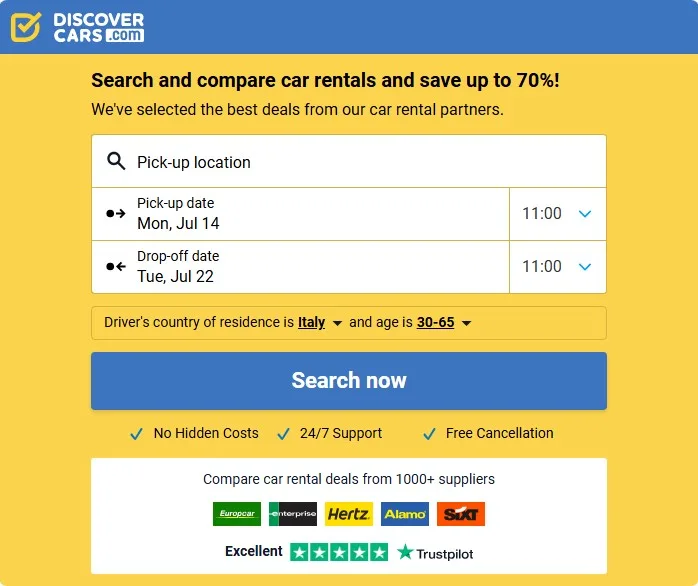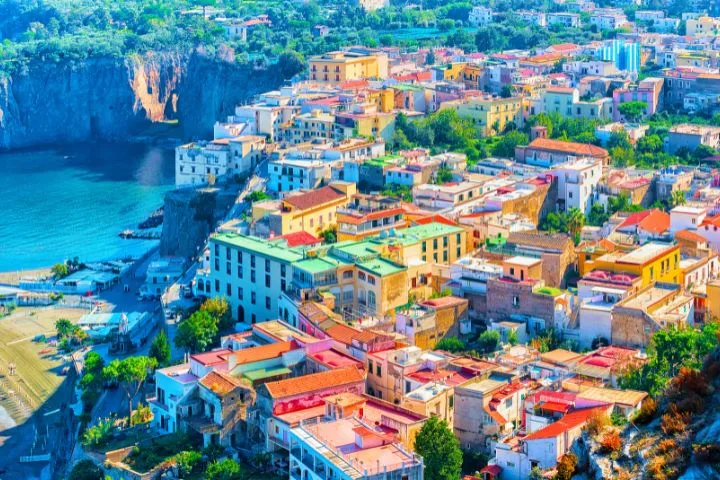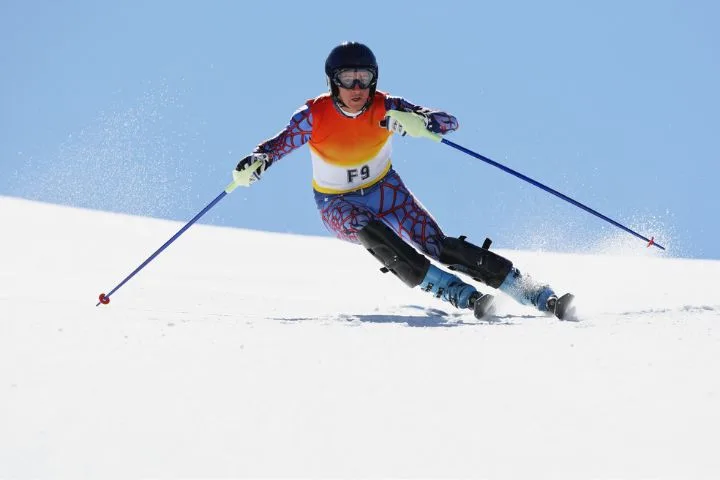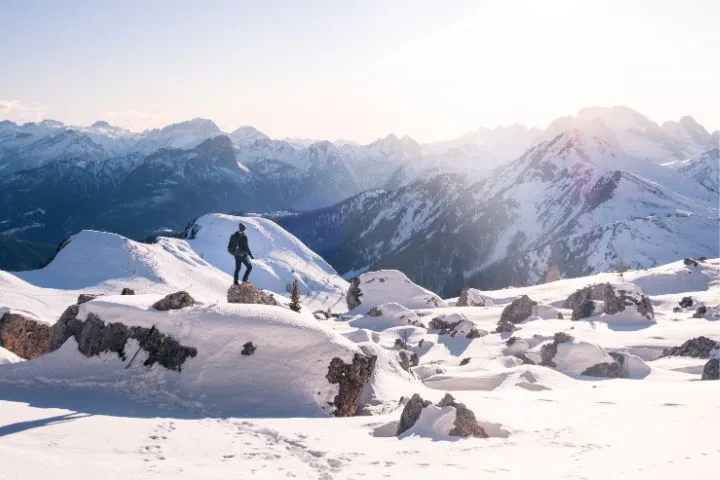Essential Winter Driving Tips For Italy: Complete Guide (2025)

by Hwan | Last Updated December 12, 2025

Planning to drive through Italy during the winter months and wondering how to navigate everything from snowy Alpine passes to icy city streets safely? After countless winter road trips across the Italian peninsula – from skiing adventures in the Dolomites to Christmas market tours in South Tyrol – I’ve learned that winter driving in Italy requires an understanding of both legal requirements and practical strategies that differ significantly from those in other countries.
Italy’s diverse geography creates dramatically different winter driving conditions within the same trip: you might encounter heavy snow and ice in the northern mountains, mild but wet conditions through central regions, and surprisingly pleasant Mediterranean weather in the south, all requiring different driving approaches and equipment.
Whether you’re renting a car for a winter vacation, driving your own vehicle across borders, or living in Italy and facing your first Italian winter behind the wheel, understanding the legal requirements, essential equipment, regional variations, and safety strategies will transform potentially stressful winter driving into confident navigation of Italy’s beautiful but challenging winter roads.
From mandatory snow chain requirements and winter tire regulations to understanding how Italian drivers adapt their behavior during winter conditions, this comprehensive guide provides the practical knowledge that ensures safe, legal, and enjoyable winter driving throughout Italy.
Italian Winter Driving Laws and Legal Requirements
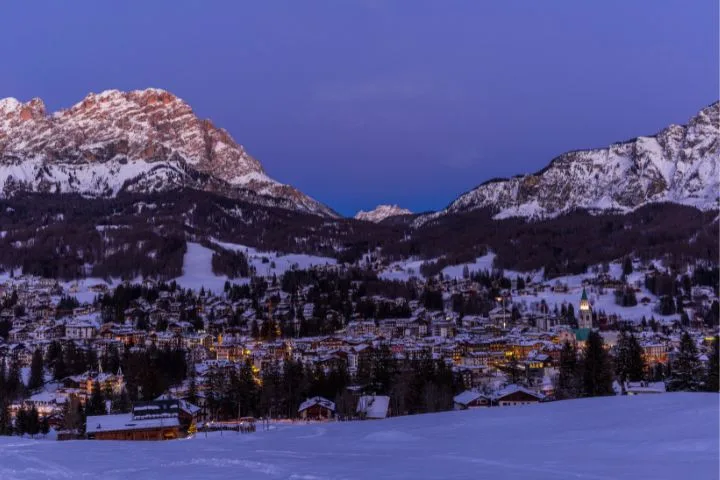
Mandatory winter tire regulations from November 15 to April 15 represent Italy’s most important winter driving law that catches many international visitors off guard. These dates are fixed regardless of actual weather conditions – even if it’s 20°C and sunny in Rome in December, you still need winter tires if you’re driving in designated zones.
Winter tires must display the M+S (Mud and Snow) marking or the three-peak mountain snowflake symbol, with minimum tread depth of 1.6mm. Quality matters here – cheap winter tires that meet legal minimums may not provide adequate safety on challenging mountain roads.
Snow chain requirements and approved chain types become mandatory when road signs indicate “Catene Obbligatorie” (chains required) or when conditions demand their use. Chains must be the correct size for your tires and easily accessible in your vehicle – stuffed in a trunk under luggage doesn’t qualify.
Not all chains meet Italian standards. Approved chains include traditional steel link chains, cable chains, and newer textile chains, but they must be TUV-certified or equivalent. Rental cars often include chains, but verifying their condition and practicing installation before you need them prevents roadside disasters.
Regional variations in enforcement and requirements can be confusing because different provinces may have different rules within the national framework. Northern regions like Trentino-Alto Adige and Valle d’Aosta enforce requirements strictly, while southern regions may be more lenient except in mountain areas.
Highway police (Polizia Stradale) conduct regular winter equipment checks, especially at Alpine pass approaches and during weather events. Being stopped without proper equipment results in immediate fines and potential vehicle impoundment until you can prove compliance.
Fines and penalties for non-compliance range from €85 to €338 for passenger cars, with additional penalties possible for causing traffic delays or accidents due to inadequate equipment. Commercial vehicles face even steeper fines, and repeat violations can result in license suspension.
International driver obligations include carrying proper documentation (passport, driver’s license, International Driving Permit, vehicle registration, insurance proof) plus understanding that your home country’s winter driving practices may not meet Italian legal standards.
Essential legal compliance checklist:
- Winter tires (M+S or mountain snowflake symbol) installed November 15 – April 15
- Approved snow chains correctly sized and easily accessible
- Current vehicle documentation and international driving permit
- Understanding of regional variations and enforcement patterns
- Emergency contact information and roadside assistance coverage
📜 Winter Driving Rules You Must Follow
Italy enforces strict winter equipment laws depending on region and dates.
- Start with the full overview of Italian driving laws & obligations → Driving in Italy: Complete Guide
- Review documentation & insurance requirements for winter travel → Car Insurance Requirements in Italy
Get our FREE Italy
Travel Guide
E-Book
This printable guide is your ultimate companion for exploring Italy, with insider tips, detailed itineraries, transportation advice, must-see attractions, and more.
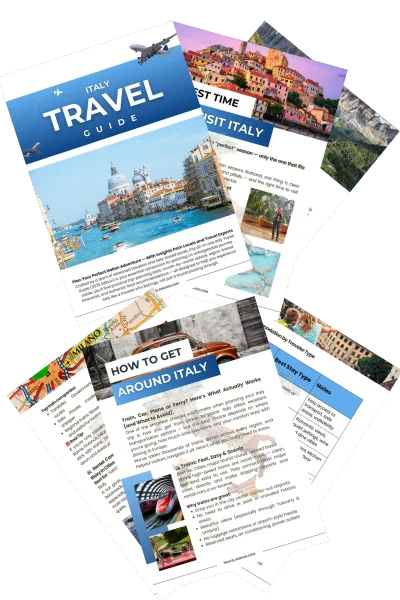
Essential Winter Equipment and Preparations in Italy
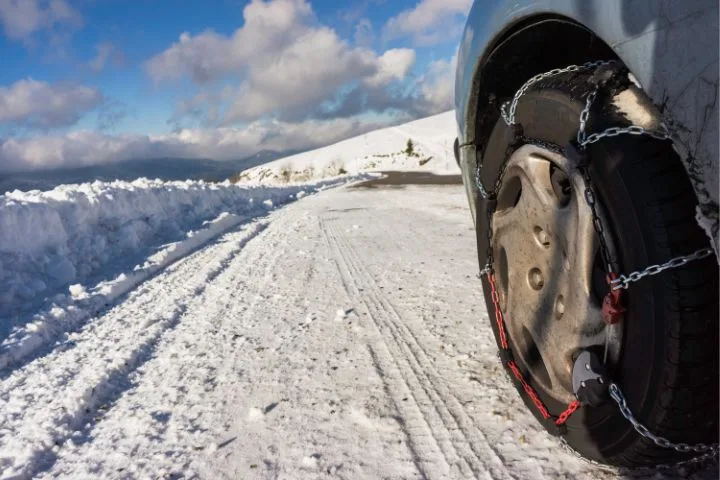
Winter tire specifications and quality standards in Italy go beyond just legal compliance to actual safety performance. While the law requires M+S markings, I strongly recommend tires with the three-peak mountain snowflake symbol, which indicates testing in severe snow conditions.
Premium winter tire brands like Michelin, Continental, and Pirelli offer significantly better performance than budget options, especially on Italy’s varied road surfaces that can transition from dry asphalt to ice within kilometers. The investment in quality tires pays dividends in safety and confidence.
Snow chain selection, sizing, and installation require matching chains precisely to your tire size and understanding installation procedures before you’re stuck in snowy conditions at night. I always practice chain installation in my driveway before trips, timing myself to ensure I can manage the process quickly.
Modern chain alternatives like Konig Easy-fit or Pewag Servo chains offer easier installation than traditional chains, while textile chains like AutoSock provide adequate traction for occasional use with simpler installation procedures.
Emergency equipment and safety supplies become essential when driving Italian mountain roads, where conditions can deteriorate rapidly. My winter travel accessories include warm clothing, emergency food and water, a flashlight with extra batteries, first aid supplies, and basic tools.
Italian mountain weather can trap vehicles for hours during storms or avalanche closures. Having supplies for extended waits prevents emergency situations from becoming dangerous, especially when traveling through remote mountain passes.
Vehicle winterization and maintenance checks should address battery condition (cold weather reduces capacity), antifreeze levels (protect to at least -25°C), wiper blades and washer fluid, and ensuring all lights function properly for reduced visibility conditions.
Insurance considerations for winter driving may include additional coverage for mountain rescue, vehicle recovery from snow, and equipment damage. Some policies exclude coverage for vehicles that are not properly equipped for winter conditions—making proper preparation essential for both safety and financial protection
Complete winter preparation essentials:
- High-quality winter tires appropriate for expected conditions
- Properly sized, TUV-certified snow chains with installation practice
- Emergency supplies for extended delays or breakdowns
- Vehicle maintenance addressing cold weather challenges
- Travel Insurance coverage adequate for mountain rescue and recovery
Mandatory Winter Gear Explained
Snow tires, chains, warning kits, and seasonal checks.
- Learn what road signs indicate mandatory winter equipment → Italian Road Signs Explained
- Make sure your rental car meets winter requirements → Best Car Rental Companies in Italy
Italy Regional Winter Driving Conditions
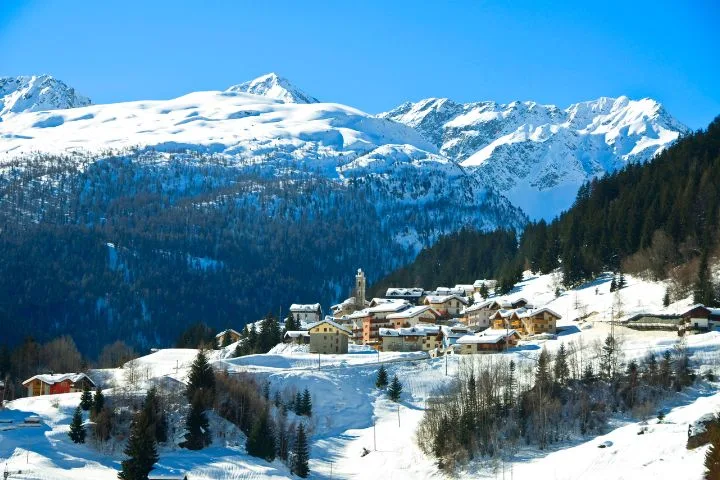
Northern Italy presents the most challenging winter driving with Alpine conditions that can include heavy snow, ice, and rapidly changing weather. The Po Valley experiences fog that can reduce visibility to near zero, while mountain areas deal with extreme weather and avalanche risks.
Cities like Milan, Turin, and Verona handle snow efficiently but experience significant traffic delays during weather events. The industrial triangle sees heavy truck traffic that creates additional challenges during winter conditions.
Central Italy’s Apennine mountains create surprising winter challenges with elevation changes that transition from mild valley conditions to snow and ice at higher elevations within short distances. The A1 autostrada between Florence and Rome regularly experiences weather-related delays and closures.
Tuscany hill towns and Umbrian mountain roads can become treacherous during winter storms, with steep grades and narrow roads that amplify winter driving challenges. These areas often lack the snow-clearing infrastructure of northern regions.
Southern Italy generally offers mild winter conditions, but can surprise unprepared drivers with occasional snow events that paralyze regions unaccustomed to winter weather. Naples and coastal areas rarely see snow, but when they do, the entire transportation system struggles.
Mountain areas of Calabria and inland Sicily can experience significant snow and ice, requiring full winter equipment despite the Mediterranean climate reputation.
Island considerations for Sicily and Sardinia include mild coastal conditions, but potential mountain weather on volcanic peaks and in the interior highlands. Etna and other high-elevation areas require winter equipment during certain months.
Urban versus rural winter driving differences are dramatic in Italy. Cities invest in snow removal and road treatment, while rural mountain roads may remain untreated for days after storms. Planning routes that prioritize maintained roads improves safety significantly.
Regional condition awareness:
- Northern Italy: Full Alpine winter conditions with comprehensive infrastructure
- Central Italy: Variable mountain conditions with less predictable maintenance
- Southern Italy: Generally mild with occasional severe weather events
- Islands: Coastal mildness with mountain exceptions requiring preparation
- Urban areas: Better maintenance but increased traffic complications
🗺️ How Winter Conditions Vary by Region
From the Alps to Tuscany and Southern Italy.
- Understand regional speed reductions during winter weather → Speed Limits in Italy for Tourists
- Learn how winter impacts toll roads & highways → Italy Toll Roads & Telepass Explained
Italian Mountain Pass Navigation and Safety

Major Alpine pass closures and seasonal restrictions affect many of Italy’s most scenic driving routes from November through May. Passes like Stelvio, Gavia, and Mortirolo close completely, while others like Brenner and Mont Blanc remain open but require winter equipment.
Real-time closure information is available through ANAS (Italian road authority) websites and apps, but conditions can change rapidly. I always have alternative routes planned and remain flexible about itineraries when mountain weather becomes challenging.
Real-time road condition monitoring through resources like Autostrade per l’Italia, regional transportation websites, and traffic apps provides essential information for safe mountain driving. Radio traffic reports on major stations offer frequent updates during weather events.
Avalanche zones and high-risk area identification require understanding that certain mountain routes pass through areas where avalanches can close roads or create dangerous conditions. Official avalanche bulletins provide risk assessments for mountain areas.
Emergency procedures for mountain breakdowns include knowing how to contact Italian emergency services (112), understanding basic Italian phrases for describing problems and locations, and carrying communication devices that work in mountain areas with limited cell coverage.
Alternative route planning becomes essential when primary mountain passes close due to weather. Having GPS systems with current maps plus paper backup maps prevents getting stranded when electronic navigation systems fail or lack current closure information.
Mountain driving safety protocols:
- Monitor weather and avalanche conditions before departure
- Carry emergency supplies for potential extended delays
- Understand communication procedures for mountain emergencies
- Plan alternative routes for major pass closures
- Respect local closure decisions and warning signs
🏔️ Driving Mountain Passes in Winter
Critical safety tips for Alpine and Apennine roads.
- In-depth guide to mountain pass driving → How to Drive Italian Mountain Passes in Winter
- Learn winter warning signs, closures & avalanche indicators → Italian Road Signs Explained
Weather Information and Road Condition Resources
Reliable Italian weather forecasting sources include MeteoAM (Italian Air Force weather service), regional meteorological services, and specialized mountain weather resources that provide detailed information for specific elevation zones and mountain areas.
I rely on multiple sources because mountain weather can be highly localized, and general weather forecasts may not reflect conditions on specific mountain passes or high-elevation routes.
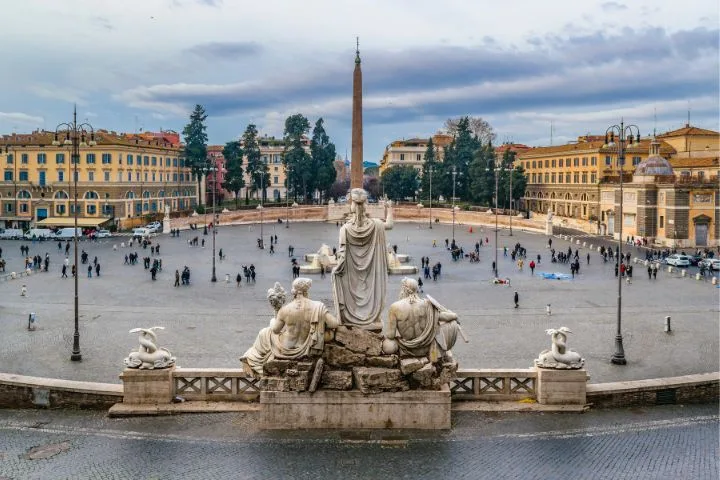
Real-time traffic and road condition apps like Waze, Google Maps, and Italian-specific apps like Luceverde provide user-reported information about current conditions, accidents, and delays. These apps integrate official road authority information with real-time user reports.
Regional transportation authority updates through websites like Autostrade per l’Italia (highways), ANAS (state roads), and provincial road departments provide official information about closures, restrictions, and required equipment for specific routes.
Emergency contact numbers and services in Italy include 112 (European emergency number), 113 (police), 115 (fire department), and 118 (medical emergency). The ACI (Italian Automobile Club) provides roadside assistance at 803.116.
Local radio stations for current conditions broadcast frequent traffic and weather updates, especially during winter weather events. Major stations like RTL 102.5 and Radio Deejay provide national coverage, while regional stations offer local detail.
Essential information resources:
- Multiple weather sources for comprehensive forecasting
- Real-time traffic apps with user-reported conditions
- Official transportation authority websites and apps
- Emergency contact numbers programmed in the phone
- Local radio frequencies for regional condition updates
Plan Your Trip with Our Favorite Booking Tools
Driving Techniques for Italian Winter Conditions
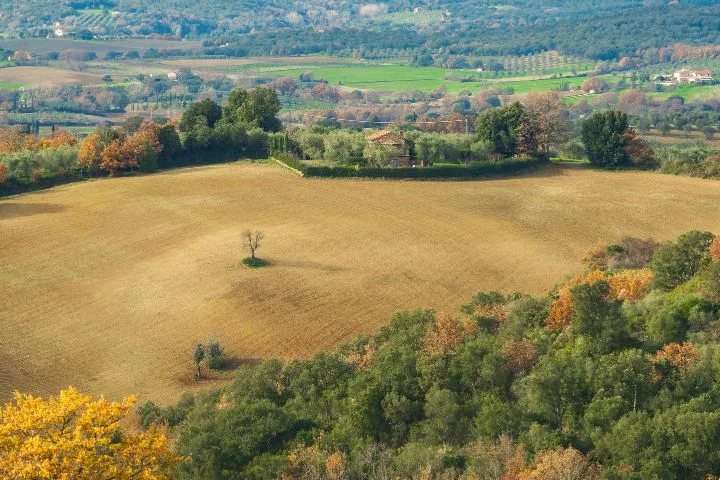
Adapting to wet conditions on varied road surfaces requires understanding that Italian roads include everything from modern highways to ancient stone streets that become slippery when wet. Reducing speed and increasing following distances becomes essential on unfamiliar surfaces.
Italian drivers generally adapt well to winter conditions, but their driving style remains more aggressive than in many other countries. Defensive driving techniques become even more important when visibility and traction are reduced.
Snow and ice driving strategies for mountain terrain include understanding how to use engine braking on descents, maintaining steady speeds on climbs, and recognizing when conditions exceed your vehicle’s capabilities, regardless of equipment.
I’ve learned that sometimes the safest decision is waiting for better conditions rather than attempting challenging mountain passes during severe weather. Italian mountain communities are accustomed to weather delays and provide accommodation and services for stranded travelers.
Italian traffic behavior changes during winter weather show that local drivers reduce the speed and increase caution, but they expect all vehicles to maintain reasonable progress. Overly cautious driving that impedes traffic flow can create dangerous situations.
Parking considerations and urban winter challenges include understanding that many Italian cities have limited parking that becomes even more scarce during weather events. Planning accommodation with parking or researching public transportation alternatives reduces stress significantly.
Fuel and gas station availability can be limited in mountain areas during severe weather. Keeping fuel tanks fuller than normal and knowing service station locations along planned routes prevents being stranded without fuel during winter storms.
Winter driving technique essentials:
- Reduced speeds with increased following distances
- Smooth inputs for steering, acceleration, and braking
- Engine braking techniques for mountain descents
- Recognition of personal and vehicle limitations
- Fuel management for extended delays and detours
Italian Emergency Procedures and Breakdown Protocols
Italian roadside assistance services include ACI (Automobile Club d’Italia) for members, insurance company assistance programs, and private towing services. Understanding how to contact appropriate services and communicate your location and problem prevents extended roadside waits.
ACI membership (available to international visitors) provides comprehensive roadside assistance, route planning, and emergency services throughout Italy. The investment often pays for itself during a single mountain breakdown or weather-related emergency.
Emergency contact procedures and language barriers require preparing basic Italian phrases for describing problems, locations, and needed assistance. Having translation apps and pre-written emergency information helps communicate with service providers who may not speak English.
What to do if stranded in mountain areas includes staying with your vehicle, conserving fuel while maintaining warmth, signaling for help appropriately, and avoiding attempts to walk for assistance in unfamiliar mountain terrain during poor weather.
Car insurance claims and accident procedures in Italy require specific documentation and procedures that may differ from those in your home country. Understanding the requirements for police reports, insurance notifications, and vehicle damage documentation helps prevent complications during stressful situations.
Communication strategies for non-Italian speakers include using smartphone translation apps, carrying written emergency information in Italian, and understanding basic gestures and phrases that communicate common roadside assistance needs.
Emergency preparedness essentials:
- ACI membership or equivalent roadside assistance coverage
- Basic Italian emergency phrases and written information
- Emergency supplies for extended waits in the vehicle
- Understanding of Italian insurance and accident procedures
- Communication tools for language barrier situations
🚨 What to Do If You Break Down in Winter
Emergency numbers, reflective vests, triangles, and tunnels.
- Review Italy’s emergency signs & procedures → Italian Road Signs Explained
- Know how insurance applies during accidents or breakdowns → Car Insurance Requirements in Italy
City-Specific Winter Driving Considerations
Milan and northern industrial cities’ challenges include sophisticated traffic management during weather events, but high traffic volumes that create delays and complications during winter storms. The comprehensive public transportation system provides alternatives when driving becomes problematic.
Rome’s winter traffic and occasional snow events can paralyze the city because snow removal infrastructure is limited for events that occur only occasionally. When Rome gets snow, the entire city essentially stops functioning normally for transportation.
Florence and Tuscan hill country conditions combine urban traffic with challenging topography that amplifies winter weather impacts. The historic city center’s narrow streets and limited parking become even more challenging during weather events.
Naples and southern urban winter characteristics rarely require winter equipment, but the chaotic traffic patterns and aggressive driving style can be complicated by occasional rainstorms and reduced visibility.
Tourist destination winter parking and access often improve during winter months when crowds disappear, but weather events can close historic centers or limit access to hilltop towns and attractions.
Urban winter driving strategies:
- Research public transportation alternatives for weather events
- Understand local traffic patterns and congestion points
- Plan parking solutions before the weather creates complications
- Respect local driving customs while maintaining safety margins
- Use weather events as opportunities to explore indoor attractions
Mastering Italian Winter Roads
After countless winter driving experiences across Italy, I can tell you that proper preparation and understanding of local requirements transform potentially stressful winter travel into confident navigation of one of Europe’s most beautiful and diverse countries during its most authentic season.
The key insight that changed my approach to Italian winter driving was realizing that the strict equipment requirements and safety regulations aren’t bureaucratic obstacles – they’re essential safety measures developed through decades of experience with challenging mountain conditions and varied weather patterns.
What makes Italian winter driving particularly rewarding is how it provides access to experiences impossible during peak tourism seasons. Snow-covered Alpine villages, misty Tuscany landscapes, and Mediterranean coastlines without crowds create travel memories that justify the extra preparation and equipment investment.
My current winter driving strategy involves comprehensive preparation before departure, flexible itineraries that account for weather delays, and appreciation for the slower pace that winter conditions encourage. Some of my most treasured Italian travel memories come from weather delays that led to unexpected discoveries and authentic local encounters.
Drive prepared, stay informed about changing conditions, and embrace the opportunity to experience Italy during the winter months when tourist crowds disappear and authentic local life becomes more accessible to visitors who understand how to navigate safely in all conditions.
Buon viaggio sicuro – safe travels!
🏁 Final Winter Driving Checklist
Prepared drivers stay safe, legal, and confident.
- Complete refresher on all Italian driving laws → Driving in Italy: Master Guide
- Pair winter driving knowledge with route planning → Best Navigation Apps for Italy
❄️ FAQs on Winter Driving in Italy Tips
Do I need snow chains or winter tires to drive in Italy during winter?
Yes, from November 15 to April 15, many Italian regions—especially in the north and mountainous areas—require winter tires or snow chains by law. Always carry chains in the trunk, even if you have winter tires.
Is it safe to drive in the Dolomites or Alps during winter?
It’s generally safe if you’re well-prepared. Roads are regularly cleared, but conditions can change quickly. Always check weather forecasts, keep fuel levels high, and drive slowly on icy or winding roads.
Can tourists rent cars equipped for winter driving in Italy?
Yes, most major rental companies offer vehicles with winter tires or include snow chains during winter months. Always confirm at booking and request written confirmation to avoid issues at pickup.
What are some key tips for navigating mountain roads in winter?
Use lower gears on steep descents, maintain a safe distance, avoid sudden braking, and practice installing snow chains before your trip. Also, plan routes with known safe parking and rest areas.
Are some regions better avoided during winter road trips in Italy?
While most areas are accessible, remote mountain roads may close due to snow or ice. Check ahead for road closures, and consider sticking to main highways and well-traveled routes during snowstorms.
💬 We’d love to hear from you!
Have questions, tips, or personal travel stories to share? Drop them in the comments below — your insights help fellow travelers plan their adventures too.

